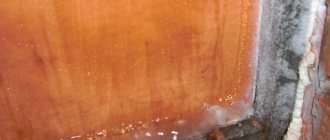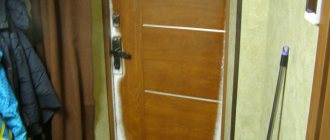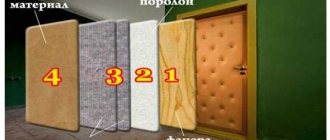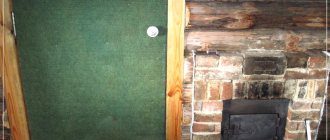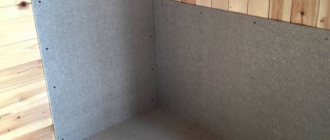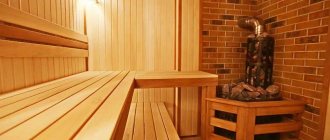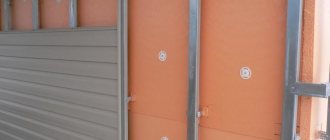The front door has two main tasks: it protects the room from unauthorized access, and also creates comfortable conditions for staying in an apartment, private house, and other buildings.
One of its main tasks is to retain heat. That is why insulation for entrance doors is of great importance and deserves attention. In this article we will look at what they are, what they consist of, and what characteristics they have. We will answer the most important and exciting questions.
Choosing a material for insulating a metal entrance door
You cannot begin work without it, which is why you first need to decide on the best option, having previously examined each of them in more detail and purchase it. There are a large number of different insulation materials on the market, making it quite easy to choose the one that suits the cost and technical parameters. For thermal insulation, you can use not only hard but also soft materials.
Mineral and stone wool
Mineral wool is in quite significant demand on the market among consumers, which has an affordable price, perfectly absorbs noise, has the ability to restore its original dimensions after compression and, due to its soft structure, is easy to use. This insulation withstands temperature fluctuations, providing complete protection of the building from the penetration of cold into it, and it is also environmentally friendly, non-flammable and allows you to vary the installation height without the need for additional cutting.
Mineral wool is supplied for sale in rolls and sheets, which makes it possible to cut blanks of the required size, which are placed in cells created by the stiffening ribs of the door structure itself. To obtain the required thickness of the insulation, you only need to press it down (pressure), which in the end will in no way negatively affect the technical performance.
The disadvantages of mineral wool include softness, which leads to shrinkage over time, but this disadvantage can be easily eliminated by creating stiffening ribs in the door structure, which prevent the material from slipping over a long period. Its significant disadvantage is its poor resistance to the influence of moisture, often acting as condensation, which occurs due to a shift in the dew point inside the door leaf. To perform high-quality insulation and avoid this drawback, it is better to give preference to stone wool.
Unlike mineral wool, it withstands its impact and allows for effective thermal insulation even of the entrance doors of private houses. In another situation, mineral wool may be a suitable option only when insulating structures that are installed in heated vestibules or corridors of apartment buildings, as well as when additionally installing a waterproofing film inside it.
Foam plastic and penoplex
Preference is given to it quite often, since the insulation has insignificant weight, which does not lead to significant weighting of the door. The material has an optimal level of strength and excellent wear resistance, and due to its hygroscopicity, it does not require additional waterproofing. In addition, polystyrene foam has high soundproofing and thermal insulation properties, thanks to which it is possible to reduce noise levels and increase heat retention inside the house, as well as prevent the penetration of cold from the street. When choosing it, you should give preference to penoplex, which, unlike ordinary material, has a higher density, which is why such insulation, even of a finer thickness, has similar qualities as ordinary sheets of standard polystyrene foam. When using it as thermal insulation, it is advisable to additionally seal all seams with polyurethane foam to prevent the formation of cold bridges.
Note! It is not recommended to use ordinary polystyrene foam for insulation, since when heated it can release substances hazardous to health.
Polyurethane foam (polyurethane foam)
Not quite a traditional option for insulating doors, but which also has a number of positive qualities and even surpasses other materials in some respects. Initially, in order to obtain an effective result, you need to be able to correctly use a spray foam gun or the tube supplied with the container, thanks to which you will not only be able to complete the work fully, but also avoid spraying an excessive amount of excess.
The material itself, due to its airy structure, does not significantly increase the weight of the door leaf, withstands temperature changes and exposure to moisture, and if you know certain nuances, it is quite simply applied and evenly fills all voids, including hard-to-reach areas.
Mineral wool
Mineral wool is produced from silicate rocks. High noise and heat insulation characteristics of the product are determined by the fibrous structure. Mineral wool is environmentally friendly, non-flammable, resistant to moisture penetration, the influence of temperature fluctuations, is not afraid of the effects of chemicals, and is also characterized by a moderate cost.
The main disadvantages of the material are subsidence under its own weight, resulting in the formation of voids. This can be avoided by installing additional stiffening ribs that can keep the insulation from slipping.
In any house or apartment, most of the heat is lost through the entrance doors. Only proper insulation of the door structure will solve this problem. If you choose the right thermal insulation material, you can reduce heat loss by 25-30%. But the choice of insulation is determined taking into account the material from which a particular door was made. Further in the article you will find which self-adhesive insulation is better to choose, its descriptions and characteristics.
Insulation of the door frame
Insulation of a metal entrance door should begin with the elements of the frame. If the box is made from a corner, then insulation is possible only in the places where the box adjoins the doorway. In this case, the gaps are filled with foam, and the excess insulation is cut off with a construction knife. If the box is made of a rectangular or square pipe, the insulation is placed inside the profile.
The better to insulate
To insulate the door frame, use foam or bulk insulation (sawdust, expanded clay).
Polyurethane foam is used to eliminate gaps between the frame and the doorway, as well as to fill the cavities of frame elements made from profiles.
Bulk insulation is used only for profiled frames. The profile is filled through a technological hole drilled in the upper part of the box. The diameter of the hole should allow the largest fractions of filler to pass through.
This method has a significant drawback: it is impossible to ensure that the entire internal space of the box is filled with bulk materials. As a result of uneven filling, voids are formed that freeze. Therefore, the use of bulk insulation is possible only in production conditions, when assembling the box in the workshop.
Materials and tools
To insulate the box you will need the following tools and materials:
- electric drill;
- metal drills with a diameter equal to the diameter of the nozzle of a cylinder with polyurethane foam;
- polyurethane foam;
- construction knife.
Insulation instructions
To fill the door frame with foam, you will need to prepare technological holes with a pitch of 500 mm. Through these holes, the internal space of the profile is filled with polyurethane foam. Excess foam coming out through the holes must be removed with a construction knife.
The gaps between the door frame and the doorway are cleaned of old insulation, moistened and filled with polyurethane foam. Excess foam is removed using a construction knife, after which the contact point between the box and the wall is masked with putty.
What is used for thermal insulation?
The traditional way to insulate a wooden entrance door is to cover its door with heat-insulating material. For this purpose use:
- mineral wool;
- batting;
- felt;
- padding polyester;
- Styrofoam;
- foam;
- foamed polyethylene or isolon with or without foil coating.
The insulating layer is covered with decorative upholstery. Most often, these are materials that create a barrier to the influence of precipitation on heat-insulating fillers. As upholstery you can use:
- leatherette;
- natural or vinyl leather;
- fabrics with water-repellent impregnation;
- When using polystyrene foam, moisture-resistant plywood or wooden lamellas such as lining can serve as upholstery.
Upholstery materials need to be purchased with a small reserve, since additional parts are made from them to insulate the joints of the box and the canvas, and the edge of the decorative material needs to be turned inward by 1-1.5 cm.
Special rollers
To seal the gap between the frame and the leaf, rollers made of the material with which the wooden door leaf will be upholstered (leatherette, leather, etc.) are used. They prevent wind from blowing through cracks and reduce the possibility of drafts. These parts are made independently in cases where the door is upholstered on the outer side, not adjacent to the frame. Inside the rollers on the wooden entrance door there should be insulation - this is thin foam rubber, isolon or other similar material.
The process of working with foam plastic
The installation of foam filler is used as a way to insulate the front door from the inside without disturbing its decorative effect. Most often this is done if the door leaf is framed and has a decorative finish for which it was purchased. Manufacturers use corrugated cardboard as a filler - a material that has a low heat-protective function. During operation, it is necessary to replace the “filling” of such a door with a layer of insulation made of foam plastic or EPS.
When performing this work, you need to dismantle the door, removing the upholstery material (plywood, fiberboard) from the canvas. The filler is removed from the cavities, leaving only the frame bars.
The foam should be cut into pieces that, as closely as possible, match the shape and size of the door cavities as closely as possible. Fasten with liquid nails or other foam adhesive. Polyurethane foam is necessary if there are gaps of more than 1-2 mm between the frame and the EPS. After installing the heat insulator inside the door, the trim panel is secured in place, and the panel is hung on the hinges.
Eliminating Gaps
Heat loss occurs not only through a metal leaf or door frame. During the installation of the structure, a so-called technological gap is created - a gap between the wall and the box, usually its dimensions are about 2 cm. For insulation work, it is best to use polyurethane foam. Simply covering the cracks with cement is not a solution, since such a mixture is not a heat-insulating material. It does not protect the room from the cold, but shrinks over time.
Thermal insulation of the technological gap must be carried out in the following sequence:
- From the side of the room, remove the casing in the place where the box comes into contact with the wall. Secure the polyethylene film.
- Remove the casing from outside the apartment. Moisten the space in the crack with water. You can use a spray bottle. This is necessary so that the polyurethane foam hardens much faster.
- Apply the first thin layer of foam. Its path should be uniform, without breaks or omissions.
- After about 20 minutes, when the first layer of foam expands, apply a second ball of it. It is necessary to ensure that the substance does not bleed beyond the perimeter of the door frame.
- When the foam has completely hardened, remove the polyethylene film that served as protection from inside the apartment.
- At the end of the work, install the platbands in place.
If the foam appears a little outside the box, it’s not a big deal. It must be carefully cut with a construction knife.
Seal installation
Another weak point in the design in terms of heat loss is the area where the sash comes into contact with the frame. If it does not fit very tightly, a draft will appear. This problem can be eliminated by installing a seal. It is produced in the form of a self-adhesive tape, which can have a different profile (section).
If the gap is small, then an oval or round seal will be useful.
If the gap is more than 3 mm, then it is worth buying a tape with a cross-section in the shape of the letter P.
Before insulating a metal entrance door, in addition to the seal itself, for insulation work you will need to acquire scissors and some kind of solvent to degrease the door.
The scheme of work is as follows:
- If an old seal was installed on the door, it must be removed and the surface thoroughly cleaned.
- Degrease the area for the tape using a solvent.
- Glue the seal around the perimeter of the sash, retreating approximately 3 mm from the outer edge. In this case, the tape must be pressed well to ensure good adhesion (without waves).
Do not pull the tape too tightly while gluing. Otherwise, it will not adhere well to the surface of the door and may come off. It is not recommended to purchase a seal that is too thick, as this may cause the door to open and close poorly.
The traditional sealing method is inconvenient
Usually special self-adhesive seals are sold for insulation. They are proposed to be glued between the door and the frame at the points of their contact. But this approach has shown to be ineffective. The seal installed in this way is very sensitive to door distortions. The slightest misalignment leads to loss of tightness, as the seal no longer fits. Installing such a tape is also not easy. Only if the door is perfectly positioned can you simply glue the strip on. Otherwise, the distance between the door and the frame is different in different places. So you have to put something under the sealing tape to ensure a secure fit.
How to insulate a door frame?
Many people think that to insulate a metal entrance door it is enough to insulate only the leaf. But in fact, the box also needs insulation. If it is made of a metal corner, then insulation can be done only along the perimeter where it adjoins the opening. To do this, just blow out all the cracks with foam. When the substance hardens, the excess can be cut off with a knife.
In the case when the box is made of a square or round pipe, then insulation can be placed inside it.
Suitable for these purposes:
- Polyurethane foam. It is convenient to seal the gaps between the wall and the frame, as well as fill all the cavities of the door frame.
- Bulk materials. This could be expanded clay, sawdust. To do this, make a hole in the profile and fill it with filler. If you perform this procedure yourself, then not all voids can be filled with material. Thorough insulation is only possible when the box is manufactured in a factory.
But you can try to do the insulation yourself. To do this, you will need a drill and suitable metal drills, the insulation itself (spray foam), and a knife.
Completing of the work:
- Holes are made every 50 cm.
- Using them, the cavity inside the box is filled with foam.
- All of its excess that has emerged through the holes is cut off with a knife.
- The gaps between the opening and the box are also filled with foam.
- When the substance becomes hard, it is cut and puttied.
Internal and external insulation of a metal door will reliably protect the room not only from thieves, but also from frost. You can carry out insulation work on your own by placing suitable material on the outside or inside of the sash. You should also take care of insulating the box and gluing the seal. Only a set of measures will prevent heat loss.
Do-it-yourself insulation of a metal entrance door
The process begins with the selection of the optimal thermal insulation material, which determines the effectiveness of insulation and its duration.
How to insulate a metal door
Types of insulation:
Penofol
Thanks to the reflective ability of the foil layer, it retains almost all the heat in the room. Used only as additional material.
Insulating a metal door with penofol
Rigid insulation
These include polystyrene foam and expanded polystyrene (penoplex). Their advantage is ease of installation and relatively low price. Since it is not hygroscopic, it does not require additional films. This is the only suitable option for installation in a cottage, country or rural house. Indeed, in this case, the door serves as a barrier to low temperatures and wind, which is not observed in apartment buildings where the door opens into the entrance.
Insulation of a metal door with polystyrene foam and polystyrene foam (penoplex)
Note. When choosing thermal insulation material, give preference to penoplex (expanded polystyrene). It is an order of magnitude denser than polystyrene foam and will provide the door with much more effective insulation.
Soft insulation
This category includes glass wool and mineral (basalt) wool. Their difference is only in the raw materials; in terms of their thermal insulation characteristics, they are not very different. Mineral wool is characterized by environmental friendliness, fire safety, and the ability to vary the installation height without additional trimming.
Cotton wool is sold in rolls or sheets, which makes it possible to cut blanks of the required sizes from it and place them in cells formed by the stiffening ribs of the door itself. To ensure the required height (thickness of insulation), simply press down the material (press cotton wool), the thermal insulation properties will not be affected.
But cotton wool has a drawback that prevents it from being recommended for installation in iron doors for private homes. Because There are different temperatures on different sides of the door, and sometimes the difference is up to 40 °C (-15 outside and +25 in the house). This leads to a shift of the dew point inside the insulation, and the wool gets wet. The effect can be neutralized by installing a hydrobarrier film.
But, nevertheless, professionals do not recommend insulating an iron door with cotton wool in a private house. It can become an acceptable option only if the entrance door to the apartment is insulated, since in this case there is not such a big difference in temperatures (it is much warmer in the entrance than outside).
Insulating a metal door with mineral wool
Inflatable insulation
Presented with polyurethane foam. Spraying makes it possible to fill all the cracks, but has a high price.
Insulation of a metal door with polyurethane foam (PPU foam)
Thermal insulation of luxury metal doors is carried out using three types of materials: foam plastic (main material), penofol (additional), polyurethane foam (filling the voids of the stiffeners and frames).
Note: a set of materials that can be found in stores is of little use for insulating an external metal door, because They use dermantin, foam rubber or synthetic winterizer as insulation.
Step-by-step instructions for insulating a wooden door in a private house
The work is carried out taking into account the characteristics of the entrance group and the installation technology of the selected insulation.
Tools and materials
In the process of working, the following set of tools, devices and materials is required:
- nail puller, pliers;
- screwdriver, hammer;
- hacksaw, jigsaw;
- tape measure, stationery knife, scissors;
- construction stapler.
It is also necessary to prepare the estimated amount of insulation, sealant, sheathing material and fasteners.
Preparatory work
At the preliminary stage, the following work is performed:
- remove the door leaf;
- unscrew door fittings and hinges;
- remove the casing, if present;
- remove old insulation and sealant residues.
Next, the canvas and box are checked for structural defects, distortions and other defects are eliminated.
Cutting and laying insulation
Based on the measurements, blanks of the required sizes are made. When arranging a frame structure, the voids are tightly filled with layers of insulation. The material is fixed using a construction stapler.
Door trim
Dermantin is mainly used as a finishing layer. The upholstery fabric should be cut taking into account a margin of 10 cm on the sides in order to create the necessary thickening around the perimeter. The upholstery is secured with decorative nails and cord to form a distinctive raised pattern. Next, install the door hardware.
The surface of the door leaf is lined with artificial leather from the inside
Seal installation
To eliminate gaps, use self-adhesive strips or install a harpoon seal. Thanks to the special shape, the product fits as tightly as possible to the base, ultimately eliminating the risk of drafts and reducing the level of heat leakage from the room.
Additional measures and means of hydro- and thermal insulation
For maximum quality insulation of a street door in a private house, the joint around the perimeter of the frame is equipped with dermantine rollers with a foam insert inside. It is recommended to line the surface of the entrance sheet with artificial leather from the inside. From the outside, the structure is sheathed with a material that is highly resistant to aggressive atmospheric influences.
Types of insulation
When choosing a suitable insulation, the performance characteristics of the material and installation features are first taken into account.
Foam rubber
This type of porous thermal insulation is one of the most affordable solutions. In addition, the installation of foam rubber is extremely simple, which makes the material popular when arranging the front door in a private home. However, in terms of functional parameters, foam rubber is somewhat inferior to modern analogues, which are endowed with improved heat and sound insulation properties.
Styrofoam
Decorating a wooden or metal sheet with polystyrene foam is considered one of the most inexpensive ways to prevent heat loss through the entrance area:
- due to the lightness of the porous composition, loads on structural elements and fastenings of the door block are eliminated;
- the presence of numerous air cells provides an effective barrier against the leakage of warm currents from the room;
- The product has high sound insulation characteristics.
Foam plastic, as a common type of insulator, is distinguished by its excellent strength and wear resistance, which determines its long service life.
Polyfoam stands out for its excellent strength and wear resistance
Minvata
Insulation based on mineral fibers promotes effective heat conservation and copes well with temperature changes. The potential of mineral wool also provides for a high level of noise absorption. The material has the ability to recover in size after compression, is easy to install, and is sold in an affordable segment. Among the disadvantages of mineral wool, susceptibility to moisture is noted. When deciding how to insulate a metal entrance door in a private house, they often give preference to stone wool, since this type of mineral wool is not afraid of a humid environment.
Mineral wool promotes effective heat conservation
Foamed polyethylene
Izolon - foamed polyethylene - is a relatively expensive type of thermal insulation. Among the competitive advantages of the material are high thermal protection properties, minimal product thickness, and the presence of an adhesive base. Thanks to the sticky surface, the isolon is easily fixed to the installed base. The structure of foamed polyethylene resembles foam rubber, but it has excellent strength indicators and provides a long service life. It is worth considering that isolon reacts negatively to prolonged exposure to UF radiation.
Polyurethane foam
The characteristic structure of polyurethane foam allows you to fill all the cavities of the surface being treated, without exception, to form a continuous thermal insulation sheet. The material is applied using special equipment. Insulating the front door with polyurethane foam requires considerable financial investment, but the high cost of the product is offset by its high performance properties.
Expanded polystyrene
Expanded polystyrene, as a type of foam, has a denser structure and, with a relatively small thickness, has similar properties as foam with more impressive dimensions. The material is not afraid of moisture, has self-extinguishing properties when exposed to flame, and is capable of providing a high level of thermal insulation of the structure being equipped.
Expanded polystyrene is capable of providing a high level of thermal insulation of the structure being equipped
Stages of plating an iron model
The sequence of actions when covering an old door depends on its design. If the design is more modern and the metal panels are attached to the base with screws, the insulation is done internally. When starting internal insulation, we remove the metal structure and place it on a work surface. Unscrew the screws and remove the metal panel (to ensure that the screws unscrew well, lubricate them with machine oil). Using a tape measure, take the dimensions of the internal cells of the door.
Carefully measure the insulation material and cut it off. Be sure to cut out a place for the door lock and peephole. For old doors, polystyrene foam or foil-lined stone wool are great. We treat the inner surface of the old structure with glue (liquid nails) and glue the prepared insulation. If there are any gaps between the old door and the insulation, fill them with foam. You must work carefully, squeezing out the mounting foam in small portions. It is important to ensure that it does not get on the bolt lock mechanism. For additional sound insulation, we lay foil insulation between the insulation and the metal sheet. We cover the structure with a metal sheet and screw in the screws.
If the old door is made by fixing metal panels by welding, then we proceed to insulate the old door using the external method. We prepare wooden blocks 20 (30) x 20 mm. We measure the parameters and cut the slats to the required length. Using a drill, we make holes for future fastening in the metal sheet. We assemble the base from prepared wooden blocks and fasten it to a metal sheet with self-tapping screws.
We prepare insulation according to the specified dimensions. We line and glue the insulation into the cells between the slats. We fix the MDF panel or board with screws. Additionally, for sound insulation, the door can be treated with leatherette from the outside or inside. To do this, we bend the leatherette and fix it with staples. Lubricate the lining and hem of the leatherette with glue (liquid nails) and press firmly against the metal sheet. This work is painstaking. At the last stage, we install door locks, handles, and a peephole. We return the finished door to its place.
When covering a single-layer metal door, it is necessary to measure the cells between the stiffeners. We cut the inner material to the specified size. We quickly glue the insulation into the cavity. We eliminate cracks and small gaps using polyurethane foam. We decorate with MDF panel.
Beautiful ideas
The appearance of the front door always emphasizes the status of the owner. Therefore, in a private home the requirements are especially high. Here it is important to take care of a decent image. The market for metal doors is saturated with a variety of products. Another good thing is that doors can be ordered according to a personal project.
And yet, how nice it is to work on the design yourself! We offer several ideas for decorating metal doors with your own hands. The design of a door in an apartment is interesting because the outside can be decorated so as not to attract other people's attention. The simplest, most affordable way is to decorate a metal door with bright fittings. You can attach new numbers to the outside, add stylized handles, hinges, and locks.
For those who prefer natural materials, we can recommend covering the inside of the door with MDF panels or simple wooden slats. The design and color of the metal door of a private house, as well as the shape, depend on the style in which the house or cottage is built. For fittings, you can use forged parts, stained glass windows, glass inclusions. And instead of a modern bell, you can hang a knocker or gong.
Tool
It is impossible to get the job done without the right set of tools. To create insulated wooden entrance doors you will need:
- Tape measure and pencil;
- Stationery knife;
- Hacksaw;
- Hammer;
- Screwdriver;
- A flat rod or metal meter;
- Mounting tool or nail puller;
- Construction stapler.
If necessary, this set can be expanded, but for most operations it will be quite sufficient. It should be noted that a hacksaw can easily be replaced with an electric jigsaw. This tool allows you to get the job done with the same quality, but much faster. And if there is no screwdriver in the house, then you can take a simple drill. The main thing is that it has a reverse, which will allow you to unscrew any self-tapping screw or screw if necessary.
In addition to the tools, it is necessary to prepare the covering material. For most door panels, it will be enough to use leatherette, which has an attractive appearance. This material has good characteristics and wear resistance, so the canvas will not need to be repaired for a long time.
And if you like to do everything with your own hands, then we recommend you instructions on how to make a wooden entrance door.
Improving the characteristics of Chinese products
The Chinese-made door is a non-demountable structure. To insulate it, remove the door and place it horizontally. We remove the handles, peephole, locks. Then we begin to attach the frame and stiffeners to it, both from the inside and from the outside. Therefore, we choose a wooden beam with a thickness of 20 * 20 mm, or more (we start from the thickness of the insulation material). If desired, you can weld a metal base, attach it with self-tapping screws or weld it to the door leaf, and fill the joints with polyurethane foam.
The next step is laying insulation. If fibrous materials are selected (mineral wool, stone wool), we lay out a water-repellent material larger in size than the base cavities, approximately 200 mm, secure with glue (liquid nails) and line the wool, having previously cut out a canvas slightly larger than the size of the base cells, and cover with another layer of water-repellent material. We fold the edges of the film tightly onto the top layer and secure with tape.
We cover the insulation with foil isolon or penofol with the foil side facing the room. This will improve the soundproofing qualities of the door. Polystyrene foam, expanded polystyrene, polystyrene, foil-coated isolon do not need waterproofing, since they themselves have water-repellent properties. Next, use a tape measure to measure the distance between the stiffeners, cut the insulation a little larger than necessary to avoid the formation of a cavity between the insulation and the base of the door. We glue the insulation into the cavity with glue (liquid nails).
We coat the base attached to the surface with mounting foam at the joints. The next step is to decorate the structure with an MDF sheet, panel or alternative material. It is important to remember that the decorative panel must be attached from the bottom up. We secure it, install locks, a peephole and handles, and hang the door. Now the door keeps the house warm and also protects from noise.
Tips and tricks
The following recommendations should be followed:
- It is best to insulate a plastic door with glass, using an additional double-glazed window;
- it is necessary to pay equal attention to both the insulation of the canvas and the thresholds and the perimeter of the doorway;
- standard Chinese metal doors immediately need to replace the insulation.
The front door requires special attention when protecting from the cold. The entire perimeter should be insulated, and the door should be closed tightly and quietly using a seal. The insulation process for doors made of plastic and metal with wood is different.
Wooden door seal is a fairly popular option.
To seal a wooden door, you can stick on any of the profiled or solid rectangular (square) materials mentioned in the previous chapter. Of course, from those that are intended for this installation (self-adhesive and installed using glue). For good reliability of attachment, you can additionally screw the sealing inserts through the washers using self-drilling screws. The installation locations are the same as for a metal door.
Or you can make the seal with your own material - in other words, with rollers. We wrap some insulation material (foam rubber is often used) in dermantine or vinyl leather. This is the roller. It must be installed in the middle of the apartment (house). Installation is performed:
- On the box - along its inner surface on the left, on the right side and on top at a small distance from the door. It is necessary to ensure that the door fits snugly against the rollers when closing. Rollers are not installed on the threshold because they wear out in a short time.
- And on the door - to its lower edge.
The rollers are secured with decorative nails along the side opposite to where the dermantine is folded in half around the foam rubber.
Insulating the front door
Despite the effectiveness of sealing using the above methods, a variety of floor strips are now used for wooden doors:
- wedge slats;
- external slats;
- plastic tubes, inserted into grooves using specialized clamps on them;
- iron and plastic strips with a brush or rubber band;
- and the rest.
A wedge-shaped rail is placed on the box in the corner between the rebate and the surface opposite the frame of the closed door. Moreover, installation is done exclusively for the upper part of the opening and its sides. Before installation, the rail is cut to the size of these installation locations. For joining points (at the top of the opening) cut at an angle of 45°. And you need to cut the rail in the places where it will adjoin the door lock and hinges. Then we hammer it in with nails.
The outer rail is placed on the door stop of the frame (in other words, it is like a continuation of the vestibule). It is also cut to the size of the opening for its top and sides. Install using self-tapping screws or self-drilling screws. After a professional installation, a sheet of paper should be placed between the rail and the closed door.
There are also strips that are mounted on the outer front side of the door, covering the gap in the opening. They are also first cut into pieces of the required sizes. Then they attach it to the door, which must be closed.
It is especially important to carry out installation with rust-resistant self-tapping screws - rusted fasteners usually provoke rotting of a wooden door
The bottom of the door opening is sealed with other types of slats, the method of using which is also slightly different. Some flashing strips are nailed to the threshold, while others are nailed to the inside face of the door. They are all cut to the width of the bottom of the door opening and fixed with self-tapping screws.
Flat threshold products consist of an aluminum or plastic base, to the bottom of which a brush or rubber plate is attached. Such slats are usually installed on both external and interior doors. After high-quality installation, the gap between the flat strip and the threshold should be small. However, the rail should not interfere with the easy, free opening and closing of the door. Certain types of flat slats are equipped with specialized (elongated) holes for screws, thanks to which you can adjust the height of their installation.
Threshold products with a plastic shield prevent the intrusion of unsaturated air into the living space (house). Basically, they are mounted on an external door.
Combined strips consist of 2 metal strips, one of which has a nylon brush attached. The product without a brush is installed on the threshold. And the strip with the brush is on the door. The threshold bar is equipped with a specialized groove that prevents water from penetrating into the middle of the room.
After high-quality installation of the combined strip, the hanging edge of the strip installed on the threshold should “look” towards the premises. And the door trim brush should exert slight pressure on the threshold strip.
